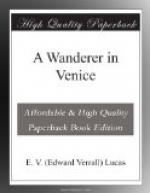“The Doge’s Palace, with its library, is a fine monument of aristocratic power. I saw the dungeons, where these scoundrels used to torment their victims. They are of three kinds—one adjoining the place of trial, where the prisoners destined to immediate execution were kept. I could not descend into them, because the day on which I visited it was festa. Another under the leads of the palace, where the sufferers were roasted to death or madness by the ardours of an Italian sun: and others called the Pozzi—or wells, deep underneath, and communicating with those on the roof by secret passages—where the prisoners were confined sometimes half-up to their middles in stinking water. When the French came here, they found only one old man in the dungeons, and he could not speak.”
CHAPTER XIII
THE GRAND CANAL. VI: FROM THE MOCENIGO PALACE TO THE MOLO, LOOKING TO THE LEFT
Mr. W.D. Howells—A gondoliers’ quarrel—Mr. Sargent’s Diploma picture—The Barbarigo family—Ruskin’s sherry—Palace hotels—The Venetian balcony.
The next palace, with dark-blue posts, gold-topped, and mural inscriptions, also belonged to the Mocenigo, and here Giordano Bruno was staying as a guest when he was betrayed by his host and burned as a heretic. Then comes the dark and narrow Calle Mocenigo Casa Vecchia. Next is the great massive palace, with the square and round porphyry medallions, of the Contarini dalle Figure; the next, with the little inquisitive lions, is the Lezze. After three more, one of which is in a superb position at the corner, opposite the Foscari, and the third has a fondamenta and arcade, we come to the great Moro-Lin, now an antiquity store. Another little modest place between narrow calli, and the plain eighteenth-century Grassi confronts us. The Campo of S. Samuele, with its traghetto, church, and charming campanile, now opens out. The church has had an ugly brown house built against it. Then the Malipiero, with its tropical garden, pretty marble rail and brown posts, and then two more antiquity stores with hideous facades, the unfinished stonework on the side of the second of which, with the steps and sottoportico, was to have been a palace for the Duke of Milan, but was discontinued.
Next the Rio del Duca is the pretty little Palazzo Falier, from one of whose windows Mr. Howells used to look when he was gathering material for his Venetian Life. Mr. Howells lived there in the early eighteen-sixties, when a member of the American Consulate in Venice. As to how he performed his consular duties, such as they were, I have no notion; but we cannot be too grateful to his country for appointing him to the post, since it provided him with the experiences which make the most attractive Anglo-Saxon book on Venice that has yet been written. It is now almost half a century since Venetian Life was published, and the author is happily still hale.




